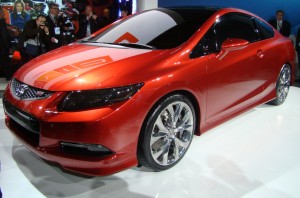
Will normally loyal import buyers switch if faced with serious shortages of products like the new Honda Civic?
The ongoing crisis in Japanese automotive manufacturing could be the biggest setback brands like Toyota, Honda and Nissan have faced in decades should anticipated product shortages send buyers scurrying to check out competing products.
Dealers could struggle with barely half their normal inventory of Japanese cars, trucks and crossover in the coming months, warns the nation’s largest automotive retailer – while analysts say that rising prices could be an equally influential factor leading to mass defections by normally loyal import buyers.
Nearly a month after Japan was rocked by a 9.0-magnitude earthquake and subsequent tsunami, a large portion of the island nation’s automotive assembly plants remain out of action or are operating at significantly reduced production schedules. Though only a few assembly lines were damaged by the disaster, scores of automotive parts plants were impacted. And compounding the situation, Japan continues to struggle with rolling blackouts in the wake of the crisis at the Fukushima Daiichi nuclear plant touched off by the quake and tsunami.
“Everybody’s in crisis mode,” said Michael Jackson, CEO of AutoNation, the Florida-based retailer that operated 243 dealerships in 15 states.
About half of AutoNation’s business comes from Japanese imports. But while two-thirds of those products are assembled in North America, even those so-called transplant assembly lines are beginning to feel the impact of the Japanese industry meltdown.
Toyota and Subaru have both put their transplant operations on reduced production schedules for several weeks, and Honda is warning workers it will likely have to idle some plants in North America. Deutsche Bank and other analysts have warned that all the transplants will likely be impacted to some degree before Japanese parts production gets back to normal – something that could take months for some of the most critical materials, such as the delicate microchips used in electronic engine controllers.
Japanese makers aren’t the only ones feeling the heat, of course.
“The impact of this is bigger than anyone knows,” says Mark Reuss, president of American operations for General Motors. But Reuss cautions that it’s not a slam dunk for Detroit, either. Shortages of Japanese-made parts forced the maker to temporarily idle a pickup plant in Louisiana, and it will also have to cut production at several European facilities.
Ford has been forced to stop taking orders for some of its more popular paint colors – including Tuxedo Black and several shades of red – because a facility owned by Merck, the only plant in the world producing the necessary pigments was damaged by the March 11 disaster.
But most industry insiders believe that Japanese makers will be hardest hit – and by a substantial margin.
That’s bad news for Honda, which is just getting ready to launch a replacement for its long-popular Civic model. The compact offering – along with Toyota’s Corolla – has long dominated its segment. But Civic is going up against an assortment of tough new competitors, such as the all-new Chevrolet Cruze, and updated Ford Focus and Hyundai Elantra models.
If the launch of the new Honda is disrupted, that could turn into a “utopia” for Detroit’s resurgent Big Three, suggests Jesse Toprak, an analyst with TrueCar.com, who contends that many traditionally loyal Toyota, Honda and Nissan buyers will switch to the domestics “out of necessity” if they can’t find the products they want – like the new Civic — on dealer lots.
Traditionally, Japanese brands have had some of the most loyal buyers. And, indeed, recent research by CNW Marketing suggests that as few as 8% of Honda buyers say they would switch brands if they had to wait more than 90 days for the car they wanted. That would jump to 14% of Toyota shoppers and 19% at Nissan. So-called second-tier Japanese brands, and Chrysler among American makers, would see potential shoppers go elsewhere rather quickly if the vehicles they want aren’t available.
But as competition heats up, loyalty rates have been declining. That’s especially true for Toyota, among the major Japanese makers, due to its ongoing safety and recall problems, analysts suggest.
“Buyers will clearly go somewhere else if they have to wait long enough,” says Art Spinella, chief analyst with CNW Marketing,
Complicating matters, import dealers have been trying to take advantage of the situation by raising prices. Early this year, shoppers could get a reasonably large discount on the Toyota Prius. But today, says TrueCar’s Toprak, they’re likely to spend as much as $3,000 over sticker.
Toyota itself is hoping to recover some cash and will raise prices on its own, come May 1st, by more than 2%.
The increase may be necessary considering the company’s financial squeeze, says analyst Spinella, but it could encourage even more buyers to defect to Detroit – or Korean or European – brands, he warns.
